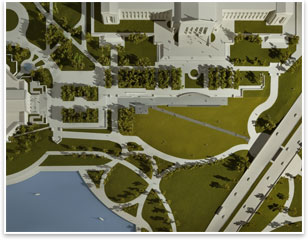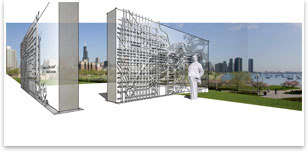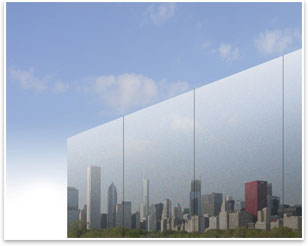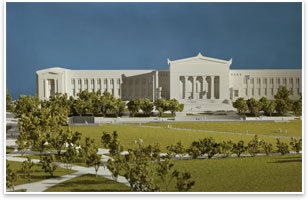
Winning
Design Chosen for Daniel Burnham Memorial
Image depicting the model of the site for the DWA-designed proposal. The proposed site for the memorial is on the Museum Campus just north of the Field Museum, overlooking Lake Michigan. Photo © James Steinkamp, Steinkamp Photography. How do you . . . design a memorial celebrating the legacy of Chicago’s famed architect and urban planner? Summary: The first-place winner of a design competition for a memorial celebrating Daniel Burnham’s impact on Chicago was announced in July. The proposed site for the memorial is on the Museum Campus just north of the Field Museum. The competition, formally known as the Burnham Memorial Design Competition, is privately funded by the Richard H. Driehaus Charitable Lead Trust and overseen by the AIA Chicago Foundation. The winning concept for the memorial was created by Chicago-based David Woodhouse Architects, LLC (DWA). The competition is part of the Burnham Plan Centennial Celebration honoring the legacy of Daniel Burnham and his fellow architect Edward Bennett's Plan of Chicago, the first planning document guiding the growth of an American city. 
DWA rendering of the Burnham Memorial Corner formation. The Corner formation is two granite memorial walls depicting elements of Burnham’s plan of downtown Chicago. A life-size statue of Burnham. Visitors pass through a tall portal for a view of Grant Park, Lake Michigan, and the city. On the outer sides of the granite walls there will be steel ribbons. The Burnham Memorial Design Competition was announced in February 2009, and 20 firms were invited to submit phase-one conceptual designs. A jury selected three finalists and three honorable mentions last April. And a seven-member jury selected DWA’s design last June. “The goal in this centennial year of the Plan of Chicago was to set the wheels in motion for a lasting memorial to Burnham and the Plan he co-wrote with Edward Bennett,” explains Peter Schlossman, AIA, president of the AIA Chicago Foundation. “The idea for the competition grew out of discussions among members of AIA Chicago’s Regional and Urban Design Knowledge Community and other partners about how Chicago’s architecture, design, and urban planning community could honor Burnham’s legacy.” 
Rendering of the inside of the Corner walls, which will reflect views of the city onto the memorial. Lakefront memorial 
Rendering of the Overlook, a long plinth of gray granite that forms a timeline of Chicago’s evolution, from prairie to present to the 2016 Olympics. DWA’s design has three primary elements: a Corner, Overlook, and Lawn.

Image depicting the model of the site for the DWA-designed proposal. Photo © James Steinkamp, Steinkamp Photography. “This isn’t a monument designed to represent Burnham,” explains David Woodhouse, FAIA. “It’s about connecting us to him and the city. Because the city is Burnham’s true monument.” Competition organizers will now seek formal public approval for the proposed memorial. A schedule of public meetings will be posted on the AIA Chicago Web site as they are confirmed. AIA Chicago will also be launching a fundraising campaign, since construction will be funded through private donations and sponsorships. |
||
Copyright 2009 The American Institute of Architects. All rights reserved. Home Page |
||
news headlines
practice
business
design
recent related
› Three Finalists Chosen in Burnham Memorial Design Competition
A three-dimensional scale model of DWA’s design and all competition entries are featured in an exhibition at the Field Museum.
The competition is endorsed by the City of Chicago and the Chicago Park District and is a joint effort of the Richard H. Driehaus Charitable Lead Trust and the AIA Chicago Foundation. The competition is being coordinated with the Burnham Centennial Initiative, which is being administered by Metropolis 2020 and is being conducted with significant organizational and financial support from the Richard H. Driehaus Charitable Lead Trust. Other key sponsors include American Airlines, The Cliff Dwellers Arts Foundation, and The Talbott Hotel.
